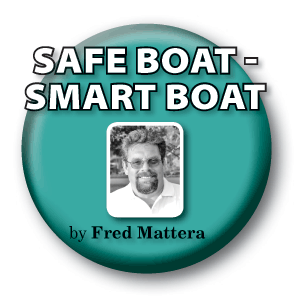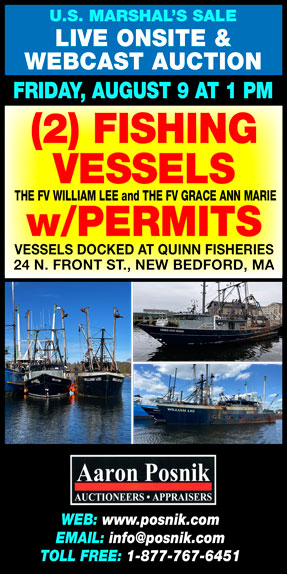[pullquote align=”left|center|right” textalign=”left|center|right” width=”100%”]
Coast Guard seeks applicants for safety advisory committee
WASHINGTON, DC – The Coast Guard is currently seeking applications for membership on its Commercial Fishing Safety Advisory Committee.
The Committee provides advice and makes recommendations to the Coast Guard and the Dept. of Homeland Security on various matters relating to the safe operation of commercial fishing industry vessels.
The Commercial Fishing Safety Advisory Committee meets at least once a year and may also meet for other extraordinary purposes.
Its subcommittees or working groups may communicate throughout the year to prepare for meetings or develop
proposals for the committee as a whole to address specific tasks.
Each member serves for a term of three years.
Completed applications should be submitted to the Coast Guard on or before Nov. 20.
For additional information, contact Jonathan Wendland, alternate designated federal officer of the Commercial Fishing Safety Advisory Committee, at (202) 372–1245 or via e-mail at <jonathan.g.wendland@uscg.mil>. /cfn/
[/pullquote]
The following is Part 3 of a four-part series focused on the decision to abandon ship and then taking the steps necessary to maximize chances for survival and rescue. Watch for the final installment in this series in a subsequent issue. —Editor
If possible when abandoning ship, board the liferaft without entering the water to avoid the effects of cold.
You may be able to jump from the rail directly into the canopy entrance. Or, if the height from the rail or foredeck (raised foc’scle vessel) is 10’ to 15’, consider using an inflated polyball with 20’ of line and take a couple of wraps around the rail or cleat.

A qualified Coast Guard-approved marine drill instructor, Fred Mattera of Point Judith, RI is the owner/president of North East Safety Training Co. (NESTCo), which conducts fishing vessel drills and inspections and basic safety training workshops.
Have each crewman step over the rail and straddle the polyball between his/her legs and lower them to a safe point of entry by slowly slacking out the line.
This minimizes the possibility of injuring a crewman inside the life raft or yourself when jumping from any distance onto the canopy.
Remember; your odds of surviving are going to be worse if you hurt yourself or a crewman.
Jumping into the water. If you must enter the water, choose a safe place to leave the vessel, keeping in mind the following points:
• If possible, enter where you can use the painter line to guide you to the liferaft. If you are not in contact with the painter line you may be swept beyond the raft.
• Beware of hazards below you. Don’t jump onto crewmen, objects, or burning oil. Jump from the lowest suitable point to minimize impact at the water.
If you are wearing a PFD. Be sure it is securely fastened. Cross your arms over your chest to help hold it down.
• Block off your nose and mouth with one hand.
• Protect your head.
• Keep your feet together in case you land on something.
• Check the area below before you jump.
• Jump feet first.
If you are wearing an immersion suit. Be sure it is fully zipped and that all closures are snug. You want it to keep water out.
• Leave the external floatation bladder deflated until you are in the water.
*l Hold the top of your suit with the inboard arm for two reasons: to protect your head and to prevent escaping air from popping the hood of your suit up over your head.
• Check the area below.
• Jump feet first, with feet together.
Stay with your vessel. If your vessel is still afloat, remain secured to it unless a fire or some other danger forces you to cut the painter. There are two good reasons for remaining attached to your vessel:
• It may not sink, and as long as it remains afloat it is a potential means of shelter. If it sinks in shallow water, it may serve as an anchor for the liferaft.
• Staying attached to your vessel keeps you closer to your last known position and makes you easier to locate, both visually and on radar.
Action in the water. Avoid staying in the water even one second longer than necessary. You will lose body
heat to the surrounding water more rapidly than it can be generated. This leads to hypothermia, unconsciousness and death.
• Wearing extra clothing will help delay the start of hypothermia. If you cannot get into the liferaft, do not
swim aimlessly. Swimming increases heat loss. Remain as still as possible, using floatation to keep you high in the water.
• Since heat loss occurs much faster (25 times) in water than in the air keep as much of your body out of the water as possible. Now is the time to inflate the external bladder on your Immersion suit by means of the mouth tube. You may be able to get on top of floating debris, a life ring, board/checkers, hatch cover, etc. to keep you out of the water.
• If you only have a PFD on use the HELP (heat escape lessening posture) technique – arms across your chest with hands under your armpits and legs curled up and crossed.
• Use your whistle to attract attention. You may not be visible, this will enable others to know where you are.
• If possible, form a group with other survivors in the water. There is safety in numbers and a group is more easily located and more likely to maintain morale. Huddling together will also decrease heat loss.
Boarding the liferaft from the water. Boarding a liferaft from the water without help is difficult.
• Pull your head and upper body in first using the boarding platform and lifelines at the raft entrance.
• It may help to bob down and use the buoyancy of your PFD or immersion suit to help lift you out of the water.
• Once your upper body is on the buoyancy tube, there should be internal lifelines to help you pull yourself all the way in. Be careful not to pull yourself in by the canopy and avoid the risk of tearing it.
Getting an injured man into the liferaft. If one of the crew is injured and unable to help himself or herself aboard the liferaft, pull the injured person in carefully to avoid aggravating the injuries.
• Have the victim face the liferaft until you get his/her upper body aboard. Pulling in with his/her back to the raft could cause additional harm if you’re dealing with a back injury.
• Once his/her hips are resting on the buoyancy tube, gently turn until the victim is on his/her back, now pull them into the liferaft.
• Keep him/her lying on their back until you determine the extent of injuries.
Righting a capsized liferaft. One person can easily right a capsized liferaft if it is done before the canopy fills with water.
• Swim to the side marked Right Here. If there is no marking go to the side with the CO2 cylinder. Maneuver the cylinder side of the raft so that it is downwind, then reach up and grab the righting strap.
• Start pulling yourself up onto the liferaft. It may help to kick your feet out as if you were swimming. Some rafts may right while you are climbing up on them. If not, stand on the very edge, where the CO2 cylinder is located. Now lean back with all your weight and pull on the righting strap.
• If the canopy is clear of water, the liferaft will begin to follow you. If the raft is large, it will land on top of you unless you spring backwards just as the raft begins to right. Another option is to have another crewman, an arm’s length away and to the side, catch the raft as it comes down and pull crew clear to avoid entanglement.
• If the raft does land on top of you, don’t panic. The bottom of the life raft is soft and flexible and your head will form an air pocket. Stay face up, catch a breath of air and pull yourself out from underneath. If you try to swim out, face down, your PFD or immersion suit could get hung up and make it difficult for you to get free.
Righting a capsized liferaft with water trapped in the canopy. If the inverted canopy fills with water, the life raft will be more difficult to right.
• Put as many crew as you can on the on the righting strap and try to pull it over.
• If you can’t right it, you may have to cut a hole in the non-vulnerable part of the canopy, taking care not to deflate the canopy or the life raft.
In Part 4, we will review the vagaries of surviving aboard the liferaft, including use of signals, treating injuries, preserving body heat, leadership and morale, and establishing the routine.
A commercial fisherman for 40 years, Mattera is a director of AMSEA, member of the Commercial Fishing Safety Advisory Committee to the Coast Guard, and, since 1998, has been president of the Point Club, a fishing vessel mutual insurance group. He also has served on the board of directors for Sunderland Marine Insurance Co. a subsidiary of North of England P & I, the principal underwriter for the Point Club and more than 2,000 US fishing vessels, since 1998.
To get access to the rest of this issue you’ll need to purchase the
NOVEMBER 2017 issue of Commercial Fisheries News.
Please choose from the following options:
• BUY a Single PRINT edition of CFN that is delivered by MAIL. PRINT EDITION
• Quickly enjoy ONLINE access with our Hi-DEF flip-book. PURCHASE THIS ONLINE EDITION
• Shop the Online ARCHIVE
(Read online flip-book immediately with purchased access key and download a copy for yourself to keep.
Not sure if it works for you? Try a FREE SAMPLE HERE.)
• SAVE BIG when you SUBSCRIBE!







